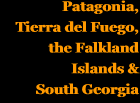The metre gauge steam locos
The first arrivals
The railway seems to have had at least ten locomotives during its life, of which the first two were present on the opening day.
No. 1
Named 'Fontana' after the Governor of Chubut, Luis Jorge Fontana. A Sharp Stewart (Atlas Works, Manchester) 0-4-2, no. 3360 of 1886. Withdrawn 1899.
An opening day train hauled by either No. 1 or No. 2.
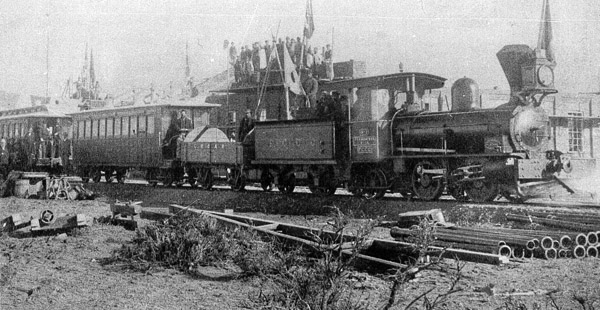
No. 2
A similar small 0-4-2, built by Sharp Stewart (no. 3361 of 1886). A photo in Gaiman Museum shows it to have had outside cylinders, inside frames, cowcatcher (pilot), balloon stack and large kerosene headlamp. It was fitted with a four wheel tender. At the opening of the railway it carried three cabside plates:
No. 2
|
Presidente
Roca
|
F. C. C. C.
|
The tender sides were inscribed F. C. C. C. The standard oval Sharp Stewart worksplate was mounted on a rectangular sandbox beside the smokebox. This loco, with all the later ones, survived until the gauge conversion in the 1920s and indeed was still recorded as being in store in 1940/1. However, one of the two had been taken out of service very early on, well before the beginning of the 20th century.
This view of loco number 2 lying derelict, is undated. However, it tends to confirm that the loco survived until after the change of gauge and possibly until after the railway closed. The three cabside plates are visible, though the Sharp Stewart worksplate on the sandbox has gone missing.
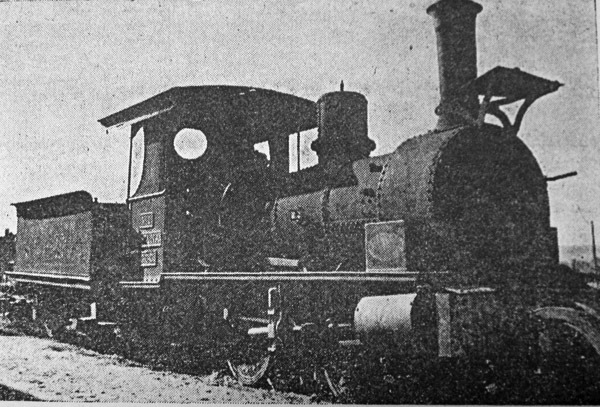
Later orders
No. 3
Beyer Peacock 2-6-0 (no. 2964 of 1888). This was almost identical to a pair of engines supplied to the EF Minas & Rio in Brazil (BP order no. 6235 of 1882), though with slightly larger cylinders and different couplers. The original design had in fact been developed for South Australia. Note that the drawing shows link and pin couplers rathr than the Norwegian choppers used by the FCCC.
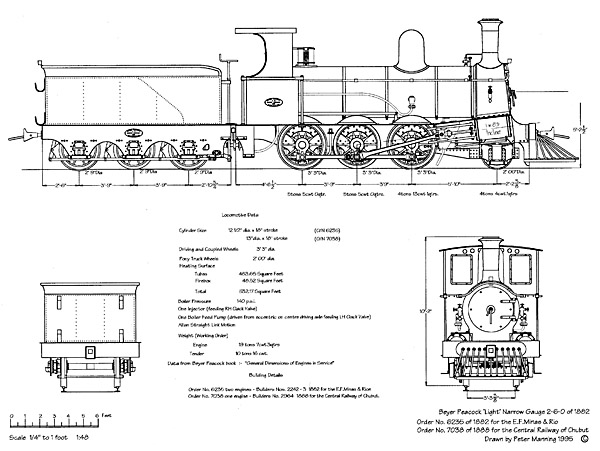
The requirements were for a loco to haul 120 tons up a 1 in 80 gradient with curves of 10 chains radius, the water to last for 50 miles. Basic dimensions were:
Cylinders: 13" x 18", Driving wheels: 3' 3", Pony truck wheels: 2',
Boiler pressure 140psi, Weight: 19tons 7cwt plus tender 10tons 16cwt.
A casing was added to the original design to cover the slide bars in the dry Patagonian climate (hand-written notes added to original drawing 33557 prepared for the earlier Minas & Rio engines ). Additional notes in the order book called for various items to be purchased from - Bolton Iron & Steel Co. (coupled axles), Bowling (boiler plates), Elliots Metal Co. (Copper plates), and for the bogie axle to be of wrought iron with case-hardened journals (1).
The tender (order no. 7039) was to have "axles of wrot iron (sic) with casehardened journals by Beyer, Peacock."
The picture shown here (2) shows No. 3 in Trelew at an unknown date. The engine is substantially as built, though with the addition of a double roof to the cab and decoration on the smokebox door. No. 3 probably inherited the 'Fontana' nameplates from No. 1 at some time, and indeed close examination of the photo does appear to show some sort of rectangular plate on the cabside. As well as having a sloping smokebox door loco no. 3 is identifiable by its running plate terminating back from the buffer beam, leaving the cylinder fronts exposed to view.
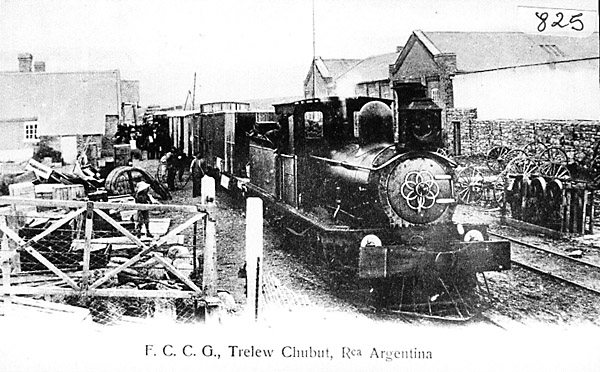
The following picture also shows loco no. 3, identifiable by the cabside cut out shape and by the lack of a running board in front of the cylinders. It is seen here at Puerto Madryn, in an enlargement from a postcard (3). The purpose of the pipes and the men on the tender is not clear. The lettering on the tender is clearly seen and there does seem to be a large rectangular plate on the cabside as mentioned above.
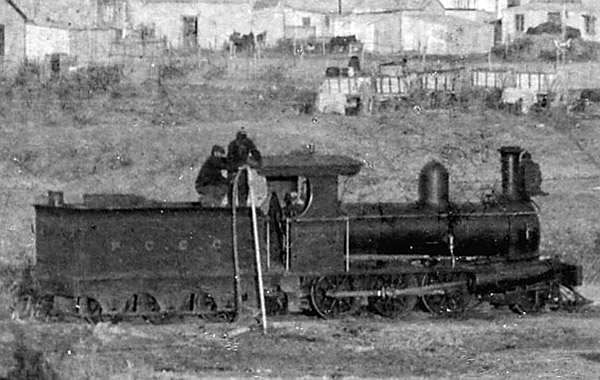
No. 3 was withdrawn at the gauge conversion sometime between 1922 and 1931 and was then stored. Surprisingly the loco survived, and by 1995 it was displayed in the centre of Puerto Madryn. It has recently been moved to the old station which is now being restored as a town museum.
A photo taken in December 2000. The sloping smokebox front is clearly visible.
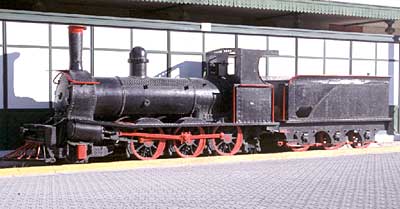
Nos. 4 & 5
Beyer Peacock 2-6-0 (nos. 4962/3 of 1907, order no. 9593). These were a slightly modified version of No. 3. A drawing is again reproduced below (1). Note that these locos had a vertical smokebox front, a slightly different cab with round spectacles, a different cabside cutout and a double roof from new. The eccentric-driven feed-water pump of the earlier engine was replaced by a crosshead driven pump. They also had a slightly larger tender water capacity. The coupled wheels had fully compensated springing, which was also a new feature for this order. Dimensions were similar to those of No.3 but with a boiler pressure of 150psi. The original notes specify the livery as "black and picked out in vermilion," though these were later deleted.
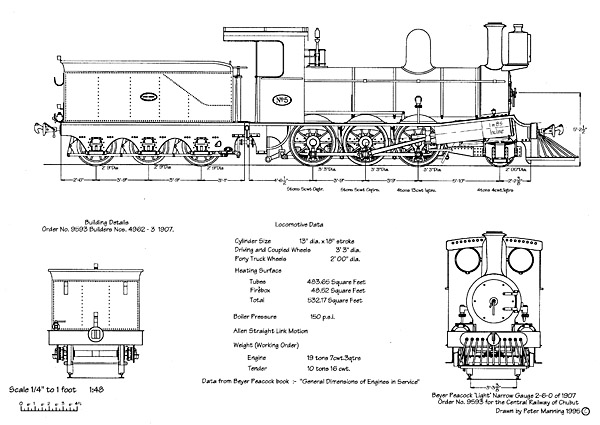
No. 5 appears to have carried the 'President Roca' plates by the time of the first war. The photo below (4) shows this engine as it left the works.
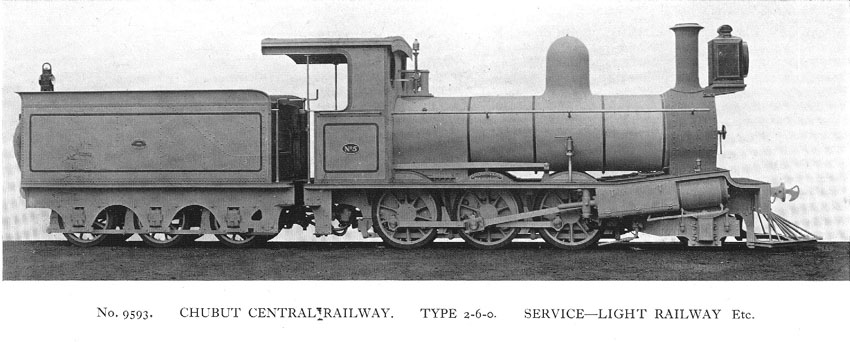
The engine of this excursion train at Joseph's Tower is either no. 4 or 5. The squared-off motion cover identifies it as either of the two 1907 locos.
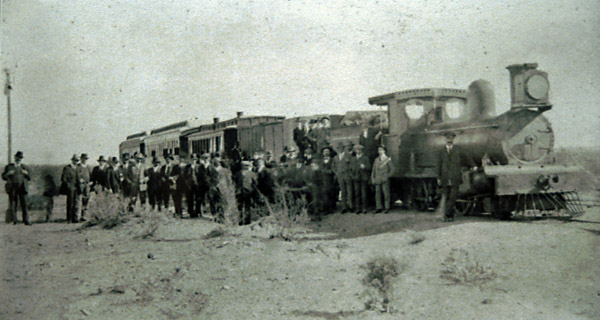
No. 6
Hudswell Clarke 2-6-0 (no. 970 of 1912). This seems to have been a direct copy of Nos. 4 & 5. It was standard practice to send a full set of drawings out with a batch of engines and passing these on to another manufacturer was not uncommon. It appears almost identical to the BP locos, Nos. 4 & 5, though with a more tubular shaped motion cover rather than the squared-off one visible above.
A works photo is displayed below. For some unknown reason the 'chopper' of the front coupling has been fitted upside-down.
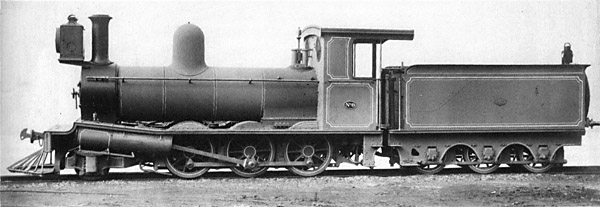
I suspect the photo below, taken in 1920, to be of No. 6. The rounded motion cover agrees with the description above, whilst the running board continues to the buffer beam so it cannot be no. 3.
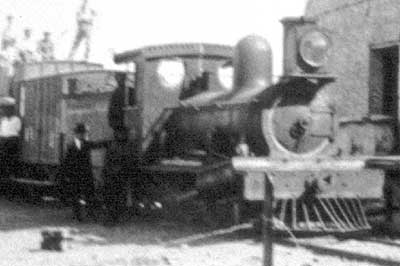
Note that in the photo below at Puerto Madryn station the coupler does not have a chopper or safety loop fitted There is also a jack on the footplate in front of the cab.
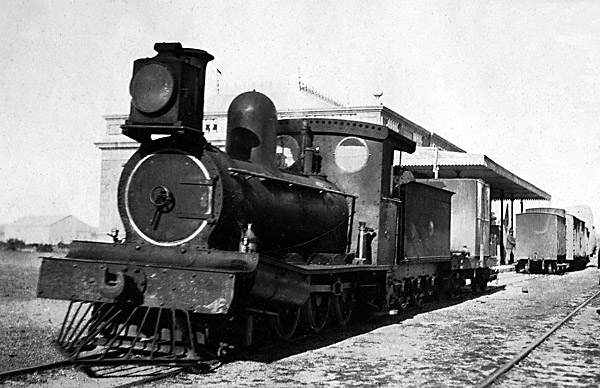
No. 21
Hunslet 0-6-0ST (no. 980 of 1908). The running number may merely imply that it was the first of a new class, though it seems strange coming after a sequence from 1 to 6. A works photo is shown below (4). Like several of the other locos, this one was still in store in 1940 (6).
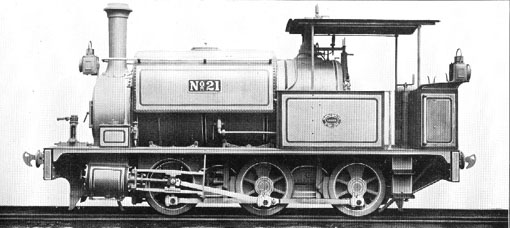
An undated photo showing the Hunslet 0-6-0T shunting on Puerto Madryn muelle.
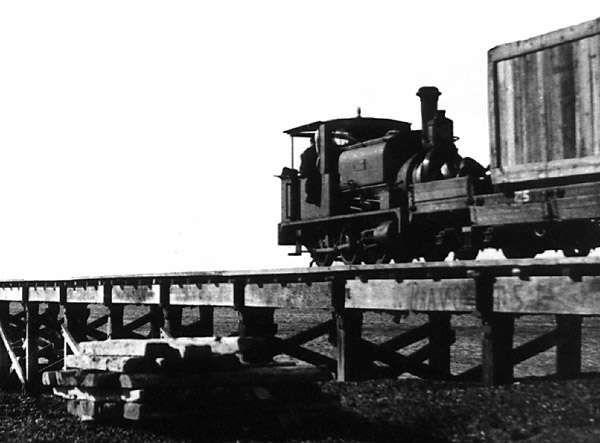
The only other known picture of loco No. 21, also on the jetty. This suggests that it was indeed mainly used for shunting at Puerto Madryn, as has been suggested elsewhere.
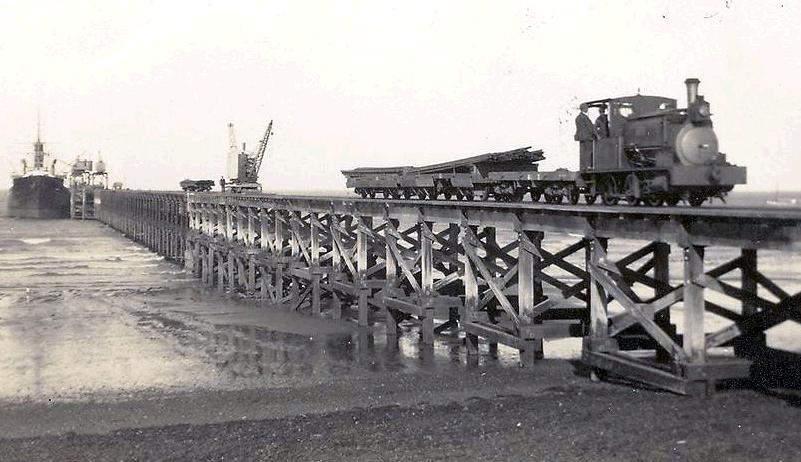
Second-hand locos
Nos. 118 & 119
According to Mr. Sydney Jones (station-master at Gaiman from 1934 - 1954) "The last two FCCC locos (Nos. 3 & 5) wore out at about the time of the First World War, and were replaced by two large locos, nos. 119 and 120" (sic) (7). These were purchased from the FC Central Norte.They were Fives Lille 2-6-0s, nos. 2756 & 2757, of 1889, ex FC San Cristóbal y Tucumán (Nos. 28-9. They had been built as 0-6-0s but gained leading pony trucks around 1898 or so. This may be an over-simplification; the probability is that these locos were actually transferred from the north in 1923 or so by the FCE, to support the continued operation of the metre gauge until the regauging to 75cm could be completed. They were apparently returned to the FC Central Norte in 1934.
The photo below shows a similar loco though from a second batch built in 1892, seen at Santa Fe station (8). Compare the wooden cattle guard with horizontal rails of typical Argentine practice with the ones supplied on the earlier locos made up of inclined rods.
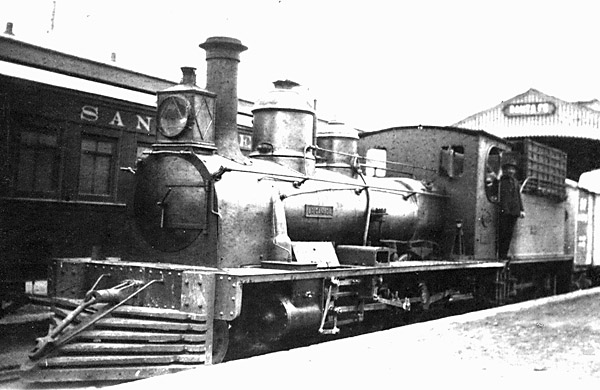
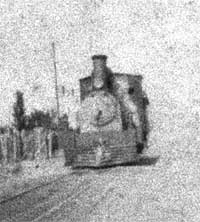
The very poor photo above is an enlargement from a shot taken at Trelew in the 1920s. I believe it shows one of the two ex FC Central Norte locos, identifiable by the parallel sides to the smokebox. A smaller headlamp has replaced that shown above.
The picture below is an enlargement of a portion of a postcard displayed elsewhere in this chapter, showing a special train arriving at a crowded Puerto Madryn station. The loco is clearly one of the two Central Norte machines.
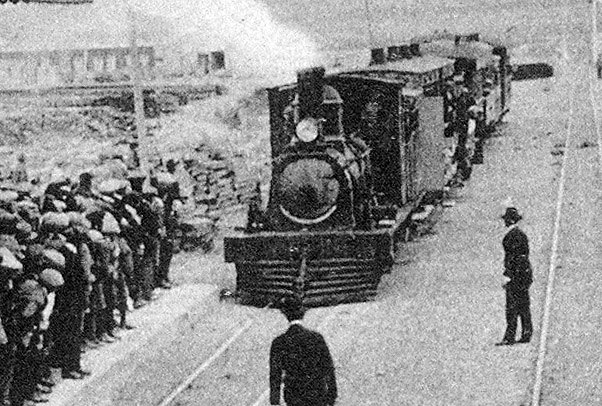
An 0-6-0T
The Railways of South America, Part 1 - Argentina (9) lists one additional loco on the FCCC metre gauge - a Fives Lille 0-6-0T of 1910. There is a suggestion that this may have come from the Santa Fe Railways. I have no further details or confirmation of this.
Classes
The locos were grouped into classes - 1 & 2 were class A, 3 to 6 were class B, 21 was class C, and 118 & 119 were class C1 (=FC Central Norte class C1).
Fuel
All engines ran on Welsh steam coal imported from Cardiff. Presumably, this would have been transhipped at Buenos Aires or Bahia Blanca to a coasting vessel.
Motor Trolley
The La Prensa newspaper of Sunday 28 July 1912 reported that the previous day a mechanised inspection trolley for management was put through its paces and covered the 70 km from Puerto Madryn to Trelew in 1 hour 10 minutes (10).
References:
1 Drawings and much useful information provided by Peter Manning in Australia.
2 Photo kindly provided by Vilma López Esteban of the Museo Regional in Trelew.
3 Postcard from the collection of Christopher Walker.
4 Works photos and many details provided by Christopher Walker.
5 A Pictorial Album of - Hudswell Clarke - Narrow Gauge Locomotives, Ronald Redman, Trent Valley Publications, PO Box 9, Burton-on-Trent, Staffordshire, DE15 9QU, UK, 1992.
6 Itinerario de Trenes No. 74, Ferrocarriles del Estado, Líneas Patagónicas, Buenos Aires, December 1940, P37 (The Summer 1941 working timetable). Engines listed as available but not used ('en depósito; no circulan'). Info via S. Damus.
7 Personal interview 1975.
8 The photo of the Fives-Lille 2-6-0 at Santa Fe is from about the 1930s, from Christopher Walker's collection.
9 The Railways of South America, Part 1 - Argentina', William Rodney Long, US Bureau of Foreign and Domestic Commerce, 1926.
10 Río Negro online 25 June 2006.
14-7-15
|

